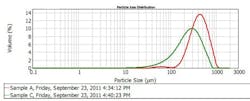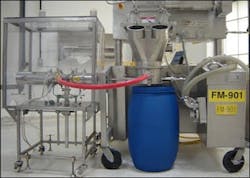Most manufacturers handling powders certainly would agree that achieving a better understanding of the materials' characteristics and how they change during processing could enhance the efficiency and safety of their operations. Fortunately, vendors are making solid progress in demystifying some key factors affecting powders.
For instance, Freeman Technology, Tewkesbury, U.K., and Medford, N.J., is looking beyond the physical properties of the particles and treating powder as a bulk entity. Using its FT4 powder rheometer, the company can evaluate and understand all the parameters that influence process performance.
"Our approach is to simulate the stresses, flow regimes and conditions that a powder may be subjected to in a process, for example, aeration, moisture absorption and electrostatic charging, and directly quantify its response," says Jamie Clayton, operations manager.
One project involved dynamic testing to meaningfully quantify differences in flow behavior between two different samples of sodium nitrite. The aim was to get the same properties in the second sample as in the first, commercially available, one.
A combination of dynamic powder testing and automated imaging showed the process for making the second sample needed modification to produce coarser particles with a smoother regular shape (Figure 1).
"The results here are not specific for sodium nitrite and in general could be true for a wide range of different powders. However, our experience tells us that when working with powders there isn't a one-size-fits-all solution; there is no such thing as a 'good' or 'bad' powder. The real question is, 'What is powder flow?' because the answer will depend on the material in question, the process concerned and what the formulation scientist or process engineer needs to achieve," notes Clayton.
For example, the properties of powder necessary for efficiency in a bulk bag filling process may significantly differ from those required when manufacturing a pharmaceutical tablet. A common preconception in both cases is that the most-free-flowing powder is needed. However, in reality, a free-flowing powder can introduce its own problems such as dusting, segregation and flooding. So, the key is to identify powders that best suit a particular process and accurately quantify their properties.
"In some unit operations, such as tableting or pneumatic conveying for example, a more cohesive powder may actually be conducive to better results. In all circumstances though, it's important to recognize that any application will consist of a series of stages and, in order to achieve efficient processing and a high-quality final product, a given powder must be compatible with all stages within the process," he adds.
MOISTURE'S ROLE
Another recent project focused specifically on controlling the impact of humidity on the powder flow properties of lactose and microcrystalline cellulose (MCC). "The main driver for this work was not only to gain a greater understanding of how humidity affects powder flow properties, but also to examine the general assumption that moisture is always detrimental to powder flow. The results illustrated how small quantities of adsorbed moisture can actually lead to an improvement in certain conditions," Clayton explains.
The two materials were selected for study because they represent powders commonly used in industry and also exhibit varying degrees of hygroscopicity. The results demonstrated that even the small quantities of moisture adsorbed by powders considered to be hydrophobic could significantly impact flow properties.
"I think we always knew that assuming moisture adsorption is always detrimental and that so-called hydrophobic powders aren't affected by humidity was over-simplistic, but this study allowed us to prove this and demonstrate how influential even minor changes in moisture content can be. It was particularly relevant that some of the greatest changes were seen across a relative humidity range that would be typical of most processing environments," he notes.
The effect of humidity on powders can be very complex; the test results show how properties such as cohesion can prevail in certain circumstances while mechanical friction or interlocking can dominate when the powder is subjected to different stress levels (Figure 2). This underscores why a multivariate testing approach is required to simulate the various stages within a specific process and understand how the powder responds.
A further study has looked at factors that influence blending kinetics, a subject still very poorly understood. Based on work carried out as part of a Ph.D. research project at the University of Birmingham, Birmingham, U.K., the study correlated positron emission tomography (PET) data with flow energy measurements. The results suggest that dynamic data may be a reliable predictor of blending behavior and, consequently, useful for developing and optimizing blending processes.
While PET primarily is used in academia and isn't an established industrial tool, Clayton believes it provides a novel comprehensive method for evaluating mixing efficiency to determine optimum parameters such as speed and mixing time to achieve uniform dispersion.
"In this study we see how two different mixtures require different process equipment settings to achieve a predefined level of acceptance. These different requirements are likely to be due to the different physical properties of the constituent powders but after applying a range of powder characterization techniques, only the FT4 was able to identify and quantify these differences," he explains.
The company says its reports and white papers — particularly those related to subjects such as caking or humidity — are generating a lot of interest from process engineers and formulation scientists across a wide range of industries.
"As a company we have experienced great success in the pharmaceutical industry where our technology lends itself well to recent initiatives such as process analytical technology and quality by design. However, the FT4 is used across a diverse range of industries including chemical, food, agriculture, powder coatings and toners. One of our existing users has recently demonstrated how minor variations in the raw ingredients and upstream process can have a major impact on the properties of household detergent tablets," notes Clayton.
OTHER KEY PARAMETERS
Analysis of particle size and shape present their own challenges when it comes to understanding how different operating conditions affect various materials. The main push from its customers is to gain insights for improving product quality and consistency, notes Malvern Instruments, Malvern, U.K. Automation can play a key role in achieving these aims, it stresses.
In one project, the company carried out successful trials of an online particle size analyzer on an active pharmaceutical ingredient (API) milling operation at a commercial site of a major manufacturer.
Like many other API makers, the company used an iterative process that required numerous offline analyses of the milled powder to verify it met the correct product specification. Time consuming and wasteful, this procedure only can show that the properties of the batch are acceptable but reveal no information about manufacturing consistency.
Following the trials, the plant installed an Insitec online particle analyzer (Figure 3). This is linked to the mill's programmable logic controller (PLC) by an Insitec PC to provide a fully integrated system; Malvern software handles data exchange. The operator interacts with the PC via the mill's human machine interface and can input set points for the control loop, remotely start and stop the analyzer and mill, perform background tests, and receive particle size results.
The benefits of automating control include improved product quality, increased throughput and less waste — especially in the form of dust. Furthermore, automation opens up a route to semicontinuous operation and real-time release — important long-term goals in reaching operational excellence.
"This system has been used in many milling campaigns, some in excess of 20 tonnes, mate with consistent quality throughout. Together with streamlining operations and ensuring excellent quality, the embedded process analytical technology (PAT) also has enabled this company to reduce offline sampling — lab work — by an amount equivalent to 30% of its initial cost per campaign," says Alon Vaisman, Westborough, Mass.-based application development manager for Malvern.
As the technology moves from early adopters to more mainstream users, Vaisman notes that such PAT solutions are becoming very widespread in the chemical and other industries: "In my view this has become more of a requirement in the western market where competition is very aggressive and improving quality is a big driver. Whether you are talking about total quality manufacturing or Six Sigma, it's all about quality control."
In an effort to further improve its online automation, Malvern has launched specialized software to control the analyzer and peripherals, plus enable integration of the analytical data into the user's control system.
"In the future, I think that more of our work will focus on developing specialized software such as this in order to make integration easier," he adds.
Looking five years ahead, Vaisman believes the needs of the biopharmaceutical and nano sectors will spur new online analytical devices based on technologies now limited to the laboratory, and there will be a wider variety of online tools available than is currently the case. He also foresees traditional manufacturers responding to low-cost competition by opting for instrumentation that now might be considered too expensive or not designed for such processes, for example as used in the food industry, to boost efficiency.
"There will also be further improvements in the ease of process integration. PAT projects are expensive today in terms of equipment and validation. I hope that an increase in standardization will lead to easier integration and faster validation," he concludes.
Of course, laboratory-based analytical techniques will continue to play an important role at many sites far into the future. So, a major study about how the reliability of analytical instruments and the reproducibility of their results changes over time by Wyatt Technology, Santa Barbara, Calif., a maker of light-scattering instrumentation, should interest many plants. The company focused on results generated by two of its size exclusion chromatography-multi angle light scattering (SEC-MALS) instruments, which are widely used when investigating how particle size and distribution can vary from batch-to-batch in different processes. The company used data collected from an independent analytical laboratory over a five-year period, an unprecedented procedure for such instruments, it believes. "The findings… found extraordinary reproducibility from day-to-day, month-to-month, and year-to-year," says Wyatt.
Seán Ottewell is Chemical Processing's Editor at Large. You can e-mail him at [email protected].





